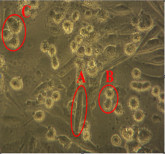Identification of Active Fatty Acid Mixture Extracted from Rice Bran Oil Using NMR Spectroscopy
http://www.doi.org/10.26538/tjnpr/v7i4.8
Keywords:
NMRspectroscopy, fatty acid, Rice bran oilAbstract
Rice bran oil (RBO) is oil obtained from rice bran. It contains fatty acids and some phytochemicals. RBO has been reported to have some biological activities. Previous publications showed the anticancer activity of rice bran oil fraction extracted from rice bran oil in LoVo, a colorectal cancer cell line through apoptosis via the MAPK pathway with the half-maximal effective concentration (EC50) value of 155.50 ± 1.10 µg/ml. Thus, this study investigated the fatty acid composition of the active rice bran oil fraction purified by column chromatography and identified by 1H and 13C NMR spectroscopy. The result showed that the active fatty acid fraction consists of saturated fatty acid and unsaturated fatty acid in a ratio of 36:64. These findings may lead to the development of alternative cancer therapies in the future.
References
Ma X, Yu H. Global burden of cancer. Yale J Biol Med. 2006;79(3-4):85-94.
Wang Y. Chapter 6 - Applications of Rice Bran Oil. In: Cheong L-Z, Xu X, editors. Rice Bran and Rice Bran Oil: AOCS Press; 2019. p. 159-68.
Rigo LA, Pohlmann AR, Guterres SS, Ruver Beck RC. Chapter 23 - Rice Bran Oil: Benefits to Health and Applications in Pharmaceutical Formulations. In: Watson RR, Preedy VR, Zibadi S, editors. Wheat and Rice in Disease Prevention and Health. San Diego: Academic Press; 2014. p. 311-22.
Dunford NT. Chapter 1 - Chemistry of Rice Bran Oil. In: Cheong L-Z, Xu X, editors. Rice Bran and Rice Bran Oil: AOCS Press; 2019. p. 1-18.
Lai O-M, Jacoby JJ, Leong W-F, Lai W-T. Chapter 2 -Nutritional Studies of Rice Bran Oil. In: Cheong L-Z, Xu X, editors. Rice Bran and Rice Bran Oil: AOCS Press; 2019. p. 19-54.
Walia M, Rawat K, Bhushan S, Padwad YS, Singh B. Fatty acid composition, physicochemical properties, antioxidant and cytotoxic activity of apple seed oil obtained from apple pomace. J Sci Food Agric. 2014;94(5):929-34.
Mericli F, Becer E, Kabadayı H, Hanoglu A, Yigit Hanoglu D, Ozkum Yavuz D, Ozek T, Vatansever S. Fatty acid composition and anticancer activity in colon carcinoma cell lines of Prunus dulcis seed oil. Pharm Biol. 2017;55(1):1239-48.
Sajid A, Manzoor Q, Iqbal M, Tyagi AK, Sarfraz RA, Sajid A. Pinus Roxburghii essential oil anticancer activity and chemical composition evaluation. Excli j. 2018;17:233-45.
Sugier D, Sugier P, Jakubowicz-Gil J, Winiarczyk K, Kowalski R. Essential Oil from Arnica Montana L. Achenes: Chemical Characteristics and Anticancer Activity. Molecules. 2019;24(22).
Verma P, Naik S, Nanda P, Banerjee S, Naik S, Ghosh A. In Vitro Anticancer Activity of Virgin Coconut Oil and its Fractions in Liver and Oral Cancer Cells. Anticancer Agents Med Chem. 2019;19(18):2223-30.
Pang W, Liu S, He F, Li X, Saira B, Zheng T, Chen J, Dong K, Pei XF. Anticancer activities of Zanthoxylum bungeanum seed oil on malignant melanoma. J Ethnopharmacol. 2019;229:180-9.
Bhat M, Jatyan R, Mittal A, Mahato RI, Chitkara D. Opportunities and challenges of fatty acid conjugated therapeutics. Chem Phys Lipids. 2021;236:105053.
Jóźwiak M, Filipowska A, Fiorino F, Struga M. Anticancer activities of fatty acids and their heterocyclic derivatives. Eur J Pharmacol. 2020;871:172937.
Szynkowska A, Siwiec E, Gutowska I, BaranowskaBosiacka I, Szczuko M, Kotlega D, Marlicz W, Stachowska E. Conjugated linoleic acids diminish glycogen synthase and glycogen synthase kinase-3 expression in muscle cells of C57BL/6J mice - in vitro and in vivo study. J Physiol
Pharmacol. 2019;70(6).
Ávila G, Catozzi C, Pravettoni D, Sala G, Martino P, Meroni G, Lecchi C, Ceciliani F. In vitro effects of conjugated linoleic acid (CLA) on inflammatory functions of bovine monocytes. J Dairy Sci. 2020;103(9):8554-63.
Zhang T, Li M, Yang R, Zhang D, Guan J, Yu J, Yang B, Zhang H, Zhang S, Liu D, Wang Y. Therapeutic efficacy of lipid emulsions of docetaxel-linoleic acid conjugate in breast cancer. Int J Pharm. 2018;546(1-2):61-9.
Ezema O, Omeje BO, Ozioko KN, Urama JC, Omeje DC,Nnawulezi H, Ejim A. A. Cholinesterase Inhibition, Biological Activity and Characterization of Chrysophyllum albidum Leaf and Stem-Bark Chloroform Extract Using GCMS: An In Vitro Study. Trop J Nat Prod Res. 2021;5(1):130-4.
Agour A, Mssillou I, Saghrouchni H, Bari A, Lyoussi B, Derwich E. Chemical Composition, Antioxidant Potential and Antimicrobial Properties of the Essential Oils of Haplophyllum tuberculatum (Forsskal) A. Juss from Morocco. Trop J Nat Prod Res. 2020;4(12):1108-15.
Adedayo BC, Adebayo AA, Oboh G. In Vitro Antioxidant and Anti-Cholinesterase Properties of Essential Oils from Pepper Fruits (Dennettia Tripetala G. Baker). Trop J Nat Prod Res. 2020;4(9):596-600.
Teipel JC, Hausler T, Sommerfeld K, Scharinger A, Walch SG, Lachenmeier DW, Kuballa T. Application of 1H Nuclear Magnetic Resonance Spectroscopy as Spirit Drinks Screener for Quality and Authenticity Control. Foods. 2020;9(10).21. Matsui T, Iwasaki H, Matsumoto K, Osajima Y. Quality Evaluation of Edible Oils by Proton Nuclear Magnetic Resonance Measurement. Food Sci Technol. 1995;1(2):94-7.
Miyake Y, Yokomizo K, Matsuzaki N. Determination of unsaturated fatty acid composition by high-resolution nuclear magnetic resonance spectroscopy. J Am Oil Chem Soc. 1998;75(9):1091-4.
Guillen M, Ruiz A. 1H Nuclear Magnetic Resonance as a fast tool for determining the proportions of the different acyl groups in acylglycerol mixtures. Eur J Lipid Sci Technol. 2003;105:502-7.
Barison A, da Silva CW, Campos FR, Simonelli F, Lenz CA, Ferreira AG. A simple methodology for the determination of fatty acid composition in edible oils through 1H NMR spectroscopy. Magn Reson Chem. 2010;48(8):642-50.
Tamvapee P, Watanapokasin R. Apoptosis Induction through MAPK Signaling Pathway in LoVo Cells by Fatty Acid Fraction from Rice Bran Oil. Nutr Cancer. 2022;74(6):2122-32.
Olabanji I, Ajayi O, Adekunle A. Fatty acids, metal composition and physico-chemical parameters of Igbemo Ekiti rice bran oil. J Environ Chem Ecotoxicol. 2013;Volume 5:Page 39-46.
Latha RB, Nasirullah DR. Physico-chemical changes in rice bran oil during heating at frying temperature. J Food Sci Technol. 2014;51(2):335-40.
Miyake Y, Yokomizo K, Matsuzaki N. Rapid determination of iodine value by 1H nuclear magnetic resonance spectroscopy. J Am Oil Chem Soc. 1998;75(1):15-9.
Guillén MaD, Ruiz A. High resolution 1H nuclear magnetic resonance in the study of edible oils and fats. Trends Food Sci Technol. 2001;12(9):328-38.

Published
How to Cite
Issue
Section
License
Copyright (c) 2023 Tropical Journal of Natural Product Research (TJNPR)

This work is licensed under a Creative Commons Attribution-NonCommercial-NoDerivatives 4.0 International License.


















